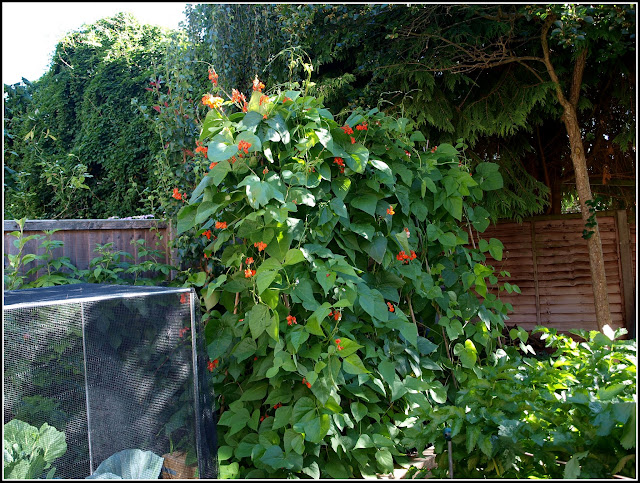Unfortunately the Blight has also enjoyed the hot conditions. Several of my tomato plants are affected with this disease. I have been doing my best to halt its spread, by inspecting all the plants very carefully at least once a day and removing any affected leaves. Most of the big Beefsteak-type tomato plants have got some sizeable fruits already, and it would be a real shame to lose them. Until yesterday I would have said that this big "Larisa" was my best prospect at present:
 |
| "Larisa" |
Regrettably yesterday's inspection showed the biggest of those fruits to be infected with blight already, and it will definitely be lost. The stems leading to the smaller fruits are also affected, so those will be lost too.
 |
| Blight is in the stems as well as on the leaves. |
"Larisa" seems to be very vulnerable to disease. Last year mine suffered badly from Blossom End Rot, and this year it was one of the first to contract blight. I have removed a lot of its leaves, so that it can concentrate on ripening some fruit, but this will probably be a battle I lose.
 |
| "Larisa" |
"Black From Tula" is looking pretty promising. It is a very big plant, and it has several fruits on it already, with more setting all the time.
 |
| "Black From Tula" |
Another big tomato is this "Caspian Pink":
 |
| "Caspian Pink" |
It's a long way off producing ripe fruit, so I just hope I can keep the blight at bay for another few weeks.
The tomato plants grown from side-shoots are basking in the warmth of the mini greenhouses still, and growing very quickly. They all have at least one truss of flowers now, though no fruit forming just yet:
Being originally of tropical origin, beans like this appreciate the warmth too, as long as they can get enough moisture. I am being very careful to keep them properly hydrated. A long soak every few days, using the hosepipe, is much better than a little superficial sprinkle every day. To keep a row of beans like mine properly watered needs about 40 - 50 litres a day, in hot weather, possibly more.(That's 4 big watering-cans).
The salads are also vulnerable to abnormally hot weather. If they don't have sufficient water they will quickly bolt. Some may even get sun-scorch (evident in the browning of leaf-edges).
Salad crops generally have a high water content (e.g. lettuce), and if they get insufficient water the plants will be tough and leathery, and probably bitter, so not good to eat.
During the very hot spell I moved my trays of salad seedlings into a shady spot to stop them getting scorched. These are lettuces, endives and radicchio, some of them nearly ready for planting-out.
This is my one and only Sweet Pepper plant:
It produced flowers very early, well before any of the chillis. One or two of the flowers even set fruit; but then the plant seemed to go into suspended animation for about 6 weeks. Luckily, the advent of much warmer weather seems to have stimulated it into growth again, and many of the embryonic fruits are beginning to swell at last. This plant goes by the nickname "Turkish Bell Pepper", because I don't know its real name. The seeds (of its parents, or is it grand-parents?) came home with us from a holiday in Turkey a few years ago. I don't like eating this type of pepper, but Jane does, so I'm growing this one to keep her happy!
This year's Cabbage-patch has done well, producing some cabbages much bigger than most of the ones I have grown previously.
The dull, relatively cool weather has suited the cabbages quite well, but they don't like blazing hot sunshine and are liable to bolt if their soil gets too dry. I temporarily moved the netting so that I could check the condition of the soil, which seemed OK. The enormous leaves provide shade for the plants' roots. Two of the cabbages are ready for harvesting and I will be cutting them in the next day or two. However, I saw that holes are beginning to appear in some of the leaves. Nothing too alarming at this stage, but something that needs to be stopped before it gets too severe.
Close inspection revealed this - the culprit caught "in flagrante delicto", as they say. He was soon dispatched!
I have also been careful to ensure that my Parsnips and Carrots have had a drink. They will survive better than most vegetables in hot weather, due to their long tap-roots, but if there is heavy rain soon after a dry spell (as seems likely this week), the roots may split.









This is so interesting to me. I am able to compare heat effects on your plants which normally grow in a cool, moist environment with mine which grow in a warmer, drier location. Blight on tomatoes is an awful thing, so difficult to control. I wouldn't dare grow a large tomato; have to get quick maturing ones to avoid disease. My peppers are problematical this year; fruit is very small sized.
ReplyDeleteSorry to hear about the blight – I hope some of the tomatoes ripen before it gets them.
ReplyDeleteYour tomatoes looks so promising. Mine needs more treatment.
ReplyDeleteWe were away from home during the two really hot days of Monday and Tuesday. Fortunately the plants seem to have survived OK without us though. You would have thought that it would have been to dry for blight over the past few days wouldn't you?
ReplyDelete